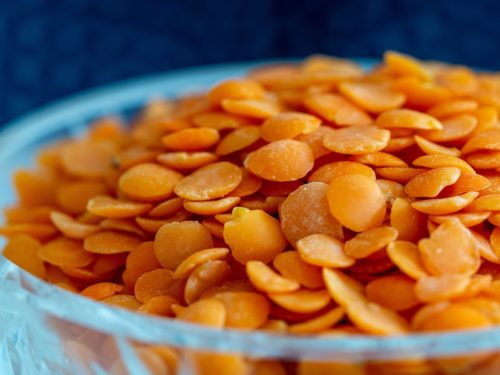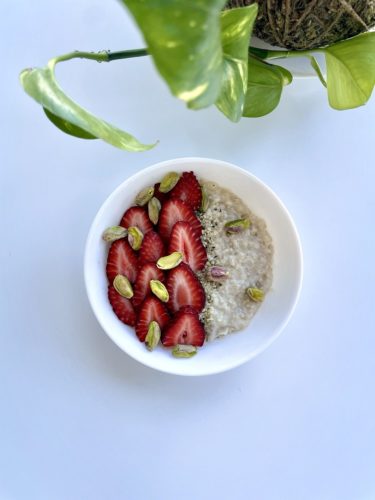Where to begin. We all want to cook healthy and eat healthy. There are more recipes than ever, and they are easy to access. Still, if you are in charge of feeding yourself or others, you can dread it. Do you go with a salad, a sandwich, or put in a little meal prep, or do you head out, get the groceries and start from scratch? Maybe you just scroll through several recipes until you get that inspiration that gets you off the couch and to the kitchen or from the job to the car to the fridge or stove. Maybe you have that great memory cooking with your grandma, and you have your go-to recipe whenever you are in a rush. I grew up eating a lot of good food, and healthy home-made meals were a given. I didn’t share in the kitchen experience that much. My cutting skills were slow, and I preferred to wipe and wash dishes early on, but once I got married out of college, it all began. Today, I’m going to give you something easy, healthy, and delicious to try: a very simple recipe for Syrian lentil soup.
But first, let me tell you about the tiny but mighty legume we call lentil. Lentils may look small and unassuming, but don’t let their size fool you. These little powerhouses are packed with nutrients and have a variety of benefits for your health.
First and foremost, lentils are a great source of protein, especially for those who follow a plant-based diet. This makes them an excellent alternative to meat for building and repairing muscles. Lentils are also high in fiber, which aids in digestion and helps keep you feeling full, making them an ideal food for weight loss or maintaining a healthy weight.
Additionally, lentils are a good source of iron, a mineral that is essential for the production of hemoglobin, the protein that carries oxygen in your blood. They also contain folate, a B vitamin that is important for brain development and can help prevent birth defects during pregnancy.
But that’s not all – lentils have even more benefits! They are low in fat and sodium, making them a heart-healthy choice, and their high potassium content can help lower blood pressure. Lentils also contain antioxidants, which help protect your cells from damage and reduce the risk of chronic diseases like cancer and Alzheimer’s.
So, whether you enjoy them in a hearty soup, as a tasty side dish, or as the star of your main course, lentils are a versatile and nutritious addition to any diet. Plus, they’re affordable and easy to find at any grocery store.
There are several different types of lentils, each with their own unique characteristics and culinary uses. Here are some of the most common types of lentils:
- Brown lentils: These are the most common variety of lentils and are readily available in most grocery stores. They have a mild, earthy flavor and hold their shape well when cooked, making them a great choice for soups, stews, and salads.
- Green lentils: These are slightly larger than brown lentils and have a slightly peppery flavor. They also hold their shape well when cooked, making them a good choice for dishes like lentil burgers or vegetarian meatballs.
- French lentils (also called Puy lentils): These are small, dark green lentils with a nutty flavor and a firm texture. They hold their shape well when cooked and are often used in salads or as a side dish.
- Red lentils: These lentils are smaller and cook more quickly than other varieties. They have a sweet, nutty flavor and a soft texture when cooked, which makes them ideal for making soups, stews, and Indian dals.
- Yellow lentils (also called split peas): These lentils are split in half and have a slightly sweet, earthy flavor. They break down completely when cooked, making them a good choice for soups and curries.
For this recipe, we traditionally use the red lentils, which are actually orange in color. This rich lentil soup was something I grew up with. It was healthy and delicious. I could come home after school and find the pot on the stove. It has beautiful red lentils, which are actually orange of course, and the texture after some time in the pressure cooker can be thicker or thinner depending on what you like. Whenever you hit up a bowl of soup, and you are not in a rush, you get that warm comforting feeling that relaxes you almost immediately. Although using the pressure cooker doesn’t give you the joy of standing over a warm pot and stirring and checking on your soup, it gives you the chance to get other things done while waiting for the pressure to build up and whistle before turning down the soup. Don’t be scared of the pressure cooker. It’s quick and easy, and you will still get that soupy aromatic smell all over the area that builds up your appetite. If the old fashioned pressure-cooker, with the whistling wobbling top (that my grandmother lovingly called “tarbouche”) isn’t for you, today’s Instant Pots work just as well.
I always love to use chicken bouillon or chicken stock since that flavor just resonates with me. I like it plain and simple so I can really enjoy the soothing flavor of the lentils, protein-packed punch by the way. I dice up some yellow onions and carmelize separately in olive oil. It’s really the richness of olive oil that adds character to the soup, so don’t skimp there, a little more won’t hurt. Of course, you have to wash the lentils. Put a cup in a shallow small dish or plastic tupperware and fill with water to rinse. I just use my hand to cup the lentils and release the water but you can use a strainer. Look for any particles that rise to the top with the foam. Give it a little stir and voila, you will have clean lentils. Off to the pot with your lentils, water, sauteed onions, spices, and potatoes, although you can add any veggies you want, and many people like to add diced carrots. I love garlic powder so of course that’s in there, and salt and pepper. Some people might add a touch of cumin, but I don’t. Place the lid, making sure it’s unobstructed, seal tight, and begin to boil. Once you hear the whistling, you can turn down the temperature and cook for twenty minutes. Alternately, you can use the Instant Pot on high pressure for 15 minutes.
Recipe
Ingredients:
1 cup red lentils (orange lentils)
7 cups water
1 cube bouillon
2 cups potatoes or other veggies
1 tbl garlic powder
6 cups water (if adding no potatoes or vegetables)
Directions:
Step 1: Measure 1 cup dry lentils
Step 2: Rinse lentils in a tupperware. Fill tupperware with lentils and then add water slowly. Foam may form and any debris or unwanted particles may rise to the top. Rinse and strain once or as many times as needed to clean lentils.
Step 3: Fill pressure cooker pot with 6 cups of water (6 cups water to 1 cup lentils ratio). If you plan to add 1 to 2 cups diced potatoes, you will need to add 1 cup of additional water, so 7 cups total. However, sometimes the potatoes will stick to the bottom of the pressure cooker even when diced small, so I prefer to cook potatoes separately. Less water or the addition of potatoes can change the texture from soup to porridge.
Step 4: Add 1 cube chicken bouillon or vegetable bouillon if you prefer to keep it vegetarian.
Step 5: Add 2 tsp granulated garlic ( I prefer more garlic, adjust as desired), 2 tsp salt & 1 tsp pepper, or desired amount to taste. For a little kick to it, add 1 tsp or more cayenne pepper
Step 6: Dice ½ a yellow onion. Onion does not have to be finely diced but keep the pieces small, depending on if you want to see and taste the texture of noticeable onion pieces. You can always puree your veggies at the end with an electric immersion blender after it’s cooked. In a saucepan, saute onions in olive oil, then add to the pot.
Step 7: Cover with lid. Cook until you hear the whistle, then turn down the heat to low for 20 minutes. You should still see the top moving a bit.
Step 8: Gently and safely let out the steam. Serve, eat, and enjoy. You can garnish with a side of pita chips if desired or tasty baguette.



This sounds right up my alley. I will have to try it! I do not have a pressure cooker so how would I adjust the recipe?
I think you could just simmer it like a stew, it just takes a lot longer.